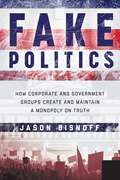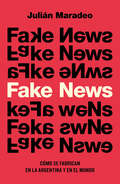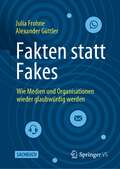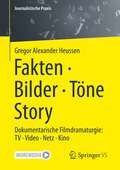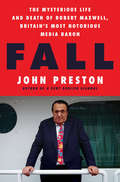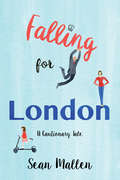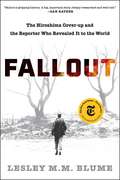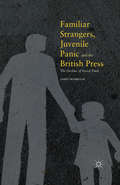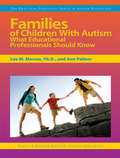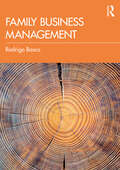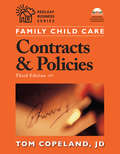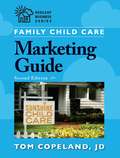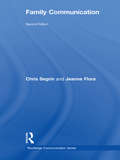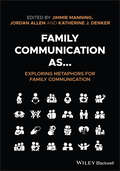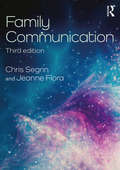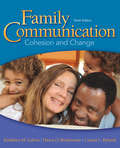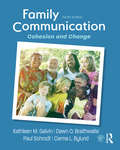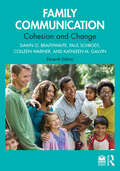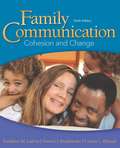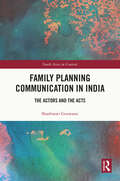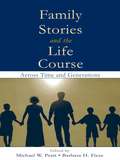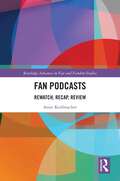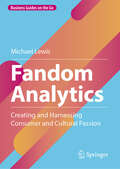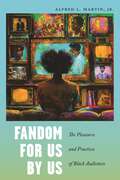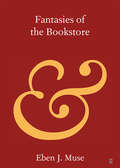- Table View
- List View
Fake Politics: How Corporate and Government Groups Create and Maintain a Monopoly on Truth
by Jason BisnoffIn “grassroots” campaigns, the grass isn’t always green—or natural.In today’s chaotic world, where the multiplication of information sources creates competing narratives, credibility is the key to winning the war of ideas. This is the reason why governments and corporations resort to astroturfing—creation of ostensibly grassroots movements set up to advance political agendas and commercial campaigns. The democratization of information and polarization of politics offer a perfect storm.Fake Politics tells the stories of how this practice has transformed political activism into a veiled lobbying effort by the rich and the powerful. Through a series of vignettes involving the tea party, oil industry, big tobacco, big data, and news media, this book will explore the similarities and differences between various campaigns that appeared as grassroots but, in reality, were lobbying efforts fueled by governments, corporations, major industries, and religious institutions.The process, named for the artificial grass fields at football stadiums and high schools across the country, became so prevalent in the last two decades that it now sits at a tipping point. In the era of “fake news” and “alternative facts,” with the truth well on its way to becoming indistinguishable from fabrication, what can the past of astroturfing tell us about the future of grassroots activism?
Fake news: Cómo se fabrican en la Argentina y en el mundo
by Julián MaradeoA partir de casos locales y del mundo, el libro cuenta la historia de las noticias falsas, de cómo nos ponen en estado de alerta y, al mismo tiempo, refleja la debilidad estatal, la falta de control y el enorme lobby alrededor de ellas. La imagen de una chica con su bebé en brazos mientras carga en la espalda una caja térmica de delivery es la punta del iceberg de un fenómeno que sacudió las nociones de verdad y mentira: las fake news. Todos estamos expuestos y a la vez las reproducimos hasta convertirlas en pandémicas. Sus consecuencias pueden alterar elecciones, decisiones de gobierno e incluso provocar muertes. A partir de casos locales y del mundo, el libro cuenta la historia de las noticias falsas, de cómo nos ponen en estado de alerta y, al mismo tiempo, reflejan la debilidad estatal, la falta de control y el enorme lobby alrededor de ellas. «Esta investigación -dice Julián Maradeo- trata sobre otra forma de ejercer el poder. Una que es imperceptible, escurridiza, placentera y extraterritorial. Una que jaquea a todas las teorías que discurrieron por siglos al respecto. Una en la que interviene un lenguaje que resulta ajeno, sujetos que parecen salidos de una película, geografías remotas. Una que pone en entredicho las reglas del juego democrático. Las noticias falsas no discriminan entre Oriente y Occidente, afectan a todos sin mirar a quién».
Fakten statt Fakes: Wie Medien und Organisationen wieder glaubwürdig werden
by Julia Frohne Alexander GüttlerFake News, PR-Skandal, Mainstream-Presse – diese Schlagworte kennzeichnen vor allem eines: den Vertrauensverlust der Öffentlichkeit in die Berichterstattung von Medien und Unternehmen. In einem nahezu unentwirrbaren Kommunikationsdschungel aus Medien, Internetportalen und sozialen Plattformen wird es nicht nur für Laien immer schwieriger, verlässliche und unseriöse Kommunikation voneinander zu unterscheiden.So steigt die Anzahl derer, die professioneller Kommunikation mit Misstrauen begegnen und in ihr vor allem Einflussnahme oder gar Manipulation sehen. Aus den Augen gerät dabei oft, dass Deutschland über eines der freiheitlichsten und vielfältigsten Mediensysteme der Welt verfügt.Das Buch diskutiert die Grenzen zwischen Manipulation und Kommunikation on- wie offline und zeigt, wie man schlampige und seriöse Meinungsmacher unterscheidet, welche Rolle Fakten spielen und wie Medien und Unternehmen dazu beitragen können, dass Glaubwürdigkeit in der medialen Debatte wieder einen Stellenwert bekommt.
Fakten · Bilder · Töne · Story: Dokumentarische Filmdramaturgie: TV · Video · Netz · Kino (Journalistische Praxis)
by Gregor Alexander HeussenDokumentarische Filme aller Genres in TV, Kino und Netz entfalten ihre informative Kraft erst dann, wenn sie dramaturgisch als Erzählungen strukturiert sind, nicht als Aufzählungen. Sie müssen die Emotionen des Publikums wecken, damit die filmische Information verstanden werden kann. Wirksame dokumentarische Filmgestaltung ist begründet in der Art, wie Menschen hinschauen und hinhören. Ihre Wahrnehmungen werden zu Vorstellungen; diese prägen die Information. Dadurch verändern sich viele überkommene Regeln für Dokumentarische Filme. Neue Ideen werden möglich. Werkzeuge dafür sind der Erzählsatz, die Roten Fäden, die Drama-Elementarmuster, das konzentrierte Zusammenspiel der sechs filmischen Erzähler, Emotionsziel und Argumentziel und die für Erzählungen charakteristische Polaritätslogik. Anders als fiktionale Filme müssen Dokumentarische Filme durch ihre erzählerische Struktur und filmische Gestaltung einen nachprüfbaren Bezug zur Lebensrealität des Publikums schaffen. Spielfilme hingegen können in ihrem jeweils definierten Erzählkosmos plausibel und authentisch sein. Im Dokumentarischen lassen sich auch Werkzeuge und Muster der Fiktionalen Dramaturgie nutzen, aber mit anderer Absicht und Wirkung: sie müssen die Lebensrealität treffen. Das Buch von Gregor Alexander Heussen zeigt Dokumentarische Dramaturgie praktisch; und begründet sie mit Erkenntnissen der Kognitionswissenschaft. Redakteure* und Film-Auftraggeber* finden Werkzeuge und Denkwege für Planung, und Filmabnahme. Autoren* erfahren die Kraft der dramaturgischen Recherche und entdecken neue Gestaltungsmöglichkeiten bei Dreh und Montage. Das Buch ist ein Muss für alle, die sich für dokumentarischen Film in TV, Kino, Netz und Unternehmen interessieren. Mit dem Buch sind 29 runterladbare, sofort nutzbare Drama-Werkzeuge verlinkt.
Fall: The Mysterious Life and Death of Robert Maxwell, Britain's Most Notorious Media Baron
by John PrestonCosta Prize Winner: The “best biography yet” of notorious media mogul Robert Maxwell, “by turns engrossing, amusing, and appalling” (Sunday Times).In February 1991, Robert Maxwell triumphantly sailed into New York Harbor on his yacht, the Lady Ghislaine, to buy the ailing Daily News. Taxi drivers stopped their cabs to shake his hand, children asked for his autograph, and patrons of the hottest restaurant in Manhattan gave him a standing ovation while he dined. Ten months later, Maxwell disappeared off that same yacht in the middle of the night and was later found dead in the water. As John Preston, author of A Very English Scandal, reveals in this biography, Maxwell’s death was as mysterious as his remarkable life.A tightly paced, addictive saga of ambition, hubris, narcissism, greed, power, and intrigue, this book recounts Maxwell’s rise and fall and rise and fall again. Preston moves backward and forward in time to examine the forces that shaped Maxwell, from his Jewish childhood in occupied Eastern Europe to his failed political ambitions in the 1960s that ended in accusations of financial double-dealing to his resurrection as a media mogul—and the family legacy he left behind, including his daughter Ghislaine Maxwell. Preston chronicles Maxwell’s all-encompassing rivalry with Rupert Murdoch—a battle that ruined Maxwell financially, threatened his sanity, and led, indirectly, to his death. Did Maxwell have a heart attack and fall overboard? Was his death suicide? Or was he murdered—possibly by Mossad or the KGB? Few in the twentieth century journeyed as far from his roots as Robert Maxwell. Yet, as Fall reveals, no one, however rich and powerful, can entirely escape their past. “Preston tells [the story] with great verve and the benefit of extensive interviews.” —The Economist“The mystery of this larger-than-life figure is perplexing—true crime aficionados will be absorbed.” —Library Journal“One of the most enigmatic figures in the annals of white-collar crime . . . well-researched, compelling.” —Kirkus Reviews
Falling for London: A Cautionary Tale
by Sean MallenWhen Sean Mallen finally landed his dream job, it fell on him like a ton of bricks.Not unlike the plaster in his crappy, overpriced London flat. The veteran journalist was ecstatic when he unexpectedly got the chance he’d always craved: to be a London-based foreign correspondent. It meant living in a great city and covering great events, starting with the Royal Wedding of William and Kate. Except: his tearful wife and six-year-old daughter hated the idea of uprooting their lives and moving to another country. Falling for London is the hilarious and touching story of how he convinced them to go, how they learned to live in and love that wondrous but challenging city, and how his dream came true in ways he could have never expected.
Fallout: The Hiroshima Cover-up and the Reporter Who Revealed It to the World
by Lesley M.M. BlumeNew York Times bestselling author Lesley M.M. Blume reveals how one courageous American reporter uncovered one of the deadliest cover-ups of the 20th century—the true effects of the atom bomb—potentially saving millions of lives. Just days after the United States decimated Hiroshima and Nagasaki with nuclear bombs, the Japanese surrendered unconditionally. But even before the surrender, the US government and military had begun a secret propaganda and information suppression campaign to hide the devastating nature of these experimental weapons. The cover-up intensified as Occupation forces closed the atomic cities to Allied reporters, preventing leaks about the horrific long-term effects of radiation which would kill thousands during the months after the blast. For nearly a year the cover-up worked—until New Yorker journalist John Hersey got into Hiroshima and managed to report the truth to the world. As Hersey and his editors prepared his article for publication, they kept the story secret—even from most of their New Yorker colleagues. When the magazine published &“Hiroshima&” in August 1946, it became an instant global sensation, and inspired pervasive horror about the hellish new threat that America had unleashed. Since 1945, no nuclear weapons have ever been deployed in war partly because Hersey alerted the world to their true, devastating impact. This knowledge has remained among the greatest deterrents to using them since the end of World War II. Released on the 75th anniversary of the Hiroshima bombing, Fallout is an engrossing detective story, as well as an important piece of hidden history that shows how one heroic scoop saved—and can still save—the world.
Familiar Strangers, Juvenile Panic and the British Press: The Decline of Social Trust
by James MorrisonThis book argues that Britain is gripped by an endemic and ongoing panic about the position of children in society – which frames them as, alternately, victims and threats. It argues the press is a key player in promoting this discourse, which is rooted in a wide-scale breakdown in social trust.
Families of Children With Autism: What Educational Professionals Should Know
by Lee M. Marcus Ann PalmerThis text provides an overview of the role of educational professionals in the lives of families of children with autism.
Family Business Management
by Rodrigo BascoFamily Business Management provides an accessible overview of the core aspects of family business, with an international, practice-based perspective. Structured in four parts, the book covers key topics such as family firm goals, conflict management, human resources, strategy, financial management, family and business governance, and succession planning. A wide variety of cases and examples are used throughout the book to highlight cultural and institutional differences between family businesses in contrasting contexts. Each chapter offers a detailed case study and boxed examples, illustrating real-life family business situations and stimulating students’ critical thinking and decision-making. Readers are further supported by learning objectives, discussion questions, and further reading suggestions. Digital supplements for instructors include lecture slides, a test bank, and additional case studies. This textbook is an ideal companion for family business courses, catering to both undergraduate and postgraduate students. It offers valuable insights and practical guidance for business families, as well as professionals working in family businesses.
Family Child Care Contracts and Policies, Third Edition
by Tom CopelandThe completely revised and expanded version of this best-selling business classic gives home-based child care providers the most updated tools needed to establish and enforce contracts and policies, build trust between provider and parent, and demonstrate provider professionalism. This new edition includes a CD-ROM with customizable worksheets and forms for creating a policy handbook and contracts designed specifically for your business.
Family Child Care Marketing Guide, Second Edition
by Tom CopelandFilled with information to effectively market a family child care program and maximize enrollment and income, Family Child Care Marketing Guide provides dozens of marketing tips and inexpensive ideas. This second edition includes two new chapters detailing the use of technology and social media as marketing tools.
Family Communication (2nd Edition)
by Chris Segrin Jeanne Flora<p>Family Communication carefully examines state-of-the-art research and theories of family communication and family relationships. In addition to presenting cutting-edge research, it focuses on classic theories and research findings that have influenced and revolutionized the way scholars conceptualize family interaction. This text offers a thorough and up-to-date presentation of scientific research in family communication for both teachers and students of family communication as well as professionals who work with families. This second edition features: <p> <li>Chapters updated with the latest research, including over 2000 references. <li>Material on understudied family relationships, such as extended family relationships and gay and lesbian relationships <li>Recent research on understudied topics in family communication, including the influence of technology on mate selection, negotiating work and family stress, single parenting, cohabitation, elder abuse, forgiveness in marriage, and the links among communication, culture, and mental health. <li>A revised chapter on parent-child communication, taking a lifespan perspective that helps organize the large body of research in this area. <li>A new chapter devoted to extended family relationships, with special focus on grandparent-grandchild relationships, in-law relationships, and adult children and their parents. <li>An expanded review of family conflict processes, especially in relation to decision making and power. <p> <p>A companion website provides chapter outlines, exam questions, and PowerPoint slides for students and instructors. Undergraduate readers should find the information easy to understand, while advanced readers, such as graduate students and professionals, will find it a useful reference to classic and contemporary research on family communication and relationships.</p>
Family Communication as... Exploring Metaphors for Family Communication
by Jimmie Manning Jordan Allen Katherine J. DenkerAn innovative textbook that presents a novel and compelling examination of family communication studies Family Communication as… Exploring Metaphors for Family Communication presents a series of metaphors through which students explore the nuances and complexities of family interaction. With a unique approach to the foundational theories and real-world practices of family communication, this easily accessible textbook helps students develop a clear understanding of what family communication is and what it can be. Contributions by both prominent and newer scholars theorize about family communication, offer new perspectives, challenge long-held assumptions, and describe original research to provide students with an up-to-date representation of the leading thinking in the field. Each concise chapter focuses on a specific element of family life, engaging key metaphors to stimulate classroom discussion about family in contexts ranging from ritual and embodiment to estrangement and heteronormativity. Throughout the text, students examine family metaphorically—as memory, as social identity, as estrangement, as loss, as resilience, as raced, and more. Presents a metaphorical examination of creating, materializing, contextualizing, politicizing, and complicating family communication Offers an innovative alternative to standard textbooks on the subject Features a thorough introduction advocating for the use of metaphors in teaching Discusses the key topics and theoretical approaches that have defined the field Includes detailed references, additional readings, and an instructor&’s companion website Family Communication as… Exploring Metaphors for Family Communication is an excellent textbook for advanced undergraduate and graduate students in courses including family communication, family studies, interpersonal communication, relational communication, and communication theory. It is also a highly useful resource for scholars in fields such as media studies, psychology, sociology, social work, counseling, and public health.
Family Communication: Chris Segrin (Routledge Communication Series)
by Chris Segrin Jeanne FloraFamily Communication carefully examines state-of-the-art research and theories of family communication and family relationships. In addition to presenting contemporary cutting-edge research, it also includes extensive presentation and application of classic theories and findings in family science that have informed current day understandings of essential family processes. This text represents a current and comprehensive presentation of information generated by principled research conducted throughout the world for both students and teachers of family communication, as well as for professionals who work with families and seek an evidence-based understanding of functional and dysfunctional family processes. New to the third edition is an expanded coverage of understudied family relationships and diverse family forms. Each chapter is carefully updated to include important new research findings generated over the past seven years (e.g., communication in families coping with military deployment, adoption, and same sex or transgender parents). The text is also accompanied by a companion website that provides additional resources for students: extended case studies relevant to various topics and chapters in the book a media guide with links to videos and other media relevant to certain topics covered in the book an additional chapter for understanding different family communication research methods) For instructors, the companion website offers: an extensive bank of discussion and test questions
Family Communication: Cohesion and Change
by Dawn O. Braithwaite Kathleen M. Galvin Carma L. BylundFamily Communication: Cohesion and Change encourages students to observe family interaction patterns analytically and relate communication theories to family interactions. Using a framework of family functions, first-person narratives, and current research, Family Communication: Cohesion and Change emphasizes the diversity of today's families in terms of structure, ethnic patterns, and developmental experiences.
Family Communication: Cohesion and Change
by Dawn O. Braithwaite Kathleen M. Galvin Paul Schrodt Carma L. BylundFamily Communication: Cohesion and Change encourages students to think critically about family interaction patterns and to analyze them using a variety of communication theories. Using a framework of family functions, current research, and first-person narratives, this text emphasizes the diversity of today's families in structure, ethnic patterns, gender socialization, and developmental experiences. New for the tenth edition are expanded pedagogical features to improve learning and retention, as well as updates on current theory and research integrated throughout the chapters for timely analysis and discussion. Cases and research featured in each chapter provide examples of concepts and themes, and a companion website offers expanded resources for instructors and students. On the book's companion website, www.routledge.com/cw/galvin, intstructors will find a full suite of online resources to help build their courses and engage their students, as well as an author video introducing the new edition: Course Materials Syllabi & Suggested Calendars Course Projects & Paper Examples Essay Assignments Test/Quiz Questions and Answer Keys Case Studies in Family Communication Family Communication Film and Television Examples Family Communication in Literature Examples Chapter Outlines Detailed Outlines Discussion Questions Case Study Questions Sample Chapter Activities Chapter PowerPoint Slides
Family Communication: Cohesion and Change
by Dawn O. Braithwaite Kathleen M. Galvin Paul Schrodt Colleen WarnerNow in its eleventh edition, Family Communication: Cohesion and Change continues to provide students with a foundational, accessible, and inclusive overview of the family communication field.The eleventh edition represents the plurality of today’s families, helping students see themselves and think through how the up-to-date research and theory apply to their lives. It features a more concise narrative with streamlined key concepts that are more straightforward and engaging for students. Now presented in three sections, Communication and Family Lenses, Communication and Family Cohesion, and Communication and Family Adaptability, this edition’s new features include learning objectives for each chapter, Family Portrait interviews with top scholars, a glossary of key definitions, and expanded Family Reflections discussion questions interspersed in the text.This book is ideal for undergraduate courses in family communication, allied subjects in communication studies, family studies, nursing, and social work programs.The accompanying Instructor and Student Resources provide free digital materials designed to test students’ knowledge and save instructor time when preparing lessons. Please visit www.routledgelearning.com/familycommunication for interactive activities, practice quizzes, and more.
Family Communication: Cohesion and Change
by Kathleen M. Galvin Dawn O. Braithwaite Carma L. BylundAddresses the role of communication in developing and maintaining functional, diverse family relationships Family Communication: Cohesion and Change encourages students to observe family interaction patterns analytically and relate communication theories to family interaction Using a framework of family functions, first-person narratives, and current research, Family Communication: Cohesion and Change emphasizes the diversity of today's families in terms of structure, ethnic patterns, and developmental experiences. MySearchLab is a part of the Galvin/Bylund/Braithwaite program. Research and writing tools, including access to academic journals, help students understand critical thinking in even greater depth. To provide students with flexibility, students can download the eText to a tablet using the free Pearson eText app. Note: this is the standalone book, if you want the book/access card order the ISBN below: 0133814998 / 9780133814996 Family Communication: Cohesion and Change plus MySearchLab with eText -- Access Card Package Package consists of: 0205239927 / 9780205239924 MySearchLab with Pearson eText -- Valuepack Access Card 0205945236 / 9780205945238 Family Communication: Cohesion and Change
Family Planning Communication in India: The Actors and the Acts (South Asia in Context)
by Shashwati GoswamiThis book is the first systematic study on the historiography of the family planning communication process in India. It traces the history of the development of a highly technical health communication process. It discusses how the discourse on India’s population problem was at the heart of the development dialogue which was being promoted by the British colonial administration. The book examines the role of the censuses and the Five-Year plans in the development of the discussion on the population ‘explosion’ in India. Also, it critically discusses the role of the Ford Foundation’s leadership in institutionalising the communication process in India. The book essentially argues that population control communication enabled the ideas of a homogenised nation, an 'ideal' Indian woman and an ‘ideal’ Indian family. This, in turn, led to the obliteration of cultural, ethnic, geographical and economic specificities of India as a country. The volume will be of great interest to scholars and researchers of public policy, media and communication studies, Indian politics, modern Indian history and South Asian Studies.
Family Stories and the Life Course: Across Time and Generations
by Michael W. Pratt Barbara H. FieseThis edited book draws from work that focuses on the act of telling family stories, as well as their content and structure. The process of telling family stories is linked to central aspects of development, including language acquisition, affect regulation, and family interaction patterns. This book extends across traditional developmental psychology, personality theory, and family studies. Drawing broadly on the epigenetic framework for individual development articulated by Erik Erikson, as well as on conceptions of the family life cycle, the editors bring together contemporary examples of psychological research on family stories and their implications for development and change at different points in the life course. The book is divided into sections that focus on family stories at different points in the life cycle, from early childhood and the beginnings of narrative skill, through adolescence, young adulthood, midlife, and then mature adulthood and its intergenerational meaning. During each of these periods of the life cycle, research focusing on individual development within an Eriksonian framework of ego strengths and virtues is highlighted. The dynamic role of family stories is also featured here, with work exploring the links between family process, intergenerational attachment, and storytelling. Sociocultural theories that emphasize how such development is situated in the wider cultural context are also featured in several chapters. This broad lifespan developmental focus serves to integrate the exciting diversity of this work and foster further questions and research in the emerging field of family narrative. The book is intended primarily for researchers and advanced-level students in the fields of developmental and personality psychology, as well as those in family studies and in gerontology. It may also be of interest to those in the helping professions who are concerned with family therapy and family issues, and may--due to its content and illustrative material--have appeal to a wider market of the lay public. The chapters are written in a readily accessible style and the analyses are presented in a fairly non-technical way. Because family stories are charted across the lifespan, it would be a suitable companion book to a more traditional lifespan textbook in certain courses.
Fan Podcasts: Rewatch, Recap, Review (Routledge Advances in Fan and Fandom Studies)
by Anne KorfmacherStarting from the observation of the ubiquity of fan podcasts engaging in media commentary, this book explores three fan podcast genres in which commentary manifests as a structuring form: rewatch and reread podcasts, recap podcasts, and review podcasts.The author conducts a formalist genre analysis of these podcasts, close reading nine case studies to describe how the three genres function and how different fan labour manifests in podcasting. Each case study teases out the themes, style, and formal constellations of the three podcast genres, shows how different fans activate the affordances of podcasting and commentary, and reveals the distinct generic functions of the three podcast genres.This book will be of significant interest to scholars and students in podcast studies, fan studies, cultural studies and literary studies who are interested in fan podcasts, podcast genre analysis, and ways of close reading podcasts as texts.
Fandom Analytics: Creating and Harnessing Consumer and Cultural Passion (Business Guides on the Go)
by Michael LewisThe success of modern sports, entertainment, political, and other cultural categories is driven by organizations’ ability to create and manage fandom. This book explores fandom from a marketing perspective providing a multidisciplinary framework for understanding, measuring, and growing fandom. It provides a fandom analytics framework for creating and managing fandom and identifies the macro forces (technology, demographics, etc.) that are changing fandom’s structure and societal role. The book goes beyond understanding the foundations of fandom by demonstrating how marketing tools may be employed to value and manage fandom assets. It is designed for existing and new generations of sports and entertainment professionals, as well as scholars, students, and academics interested in sports and entertainment marketing and analytics.
Fandom for Us, by Us: The Pleasures and Practices of Black Audiences (Postmillennial Pop)
by Alfred L. Jr.The convergence of the politics of representation and Black fan culturesBoldly going where few fandom scholars have gone before, Fandom for Us, by Us breaks from our focus on white fandom to center Black fandoms. Alfred L. Martin, Jr., engages these fandoms through what he calls the “four C’s”: class, clout, canon, and comfort.Class is a key component of how Black fandom is contingent on distinctions between white, nationally recognized cultural productions and multicultural and/or regional cultural productions, as demonstrated by Misty Copeland’s ascension in American Ballet Theatre. Clout refers to Black fans’ realization of their own consumer spending power as an agent for industrial change, reducing the precarity of Blackness within historically white cultural apparatuses and facilitating the production of Black blockbusters like 2018’s Black Panther. Canon entails a communal fannish practice of sharing media objects, like the 1978 film The Wiz, which lead them to take on meanings outside of their original context. Comfort describes the nostalgic and sentimental affects associated with beloved fan objects such as the television show, Golden Girls, connected to notions of Black joy and signaling moments wherein Black people can just be themselves.Through 75 in-depth interviews with Black fans, Fandom for Us, by Us argues not only for the importance of studying Black fandoms, but also demonstrates their complexities by both coupling and decoupling Black reception practices from the politics of representation. Martin highlights the nuanced ways Black fans interact with media representations, suggesting class, clout, canon, and comfort are universal to the study of all fandoms. Yet, for all the ways these fandoms are similar and reciprocal, Black fandoms are also their own set of practices, demanding their own study.
Fantasies of the Bookstore (Elements in Publishing and Book Culture)
by Eben J. MuseThis Element surveys the place of the bookstore in the creative imagination (the fantasies of the bookstore) through a study of novels in which bookstores play a prominent role in the setting or plot. Nearly 500 'bookstore novels' published since the first in 1917 have been identified. The study borrows the concept of 'meaningful locations' from the field of human geography to assess fictional bookstores as narrative events rather than static backgrounds. As a meaningful location, the bookstore creates the potential for events that can occur both within the place of the store and in the wider space within which it functions. Elements of the narrative space include its spatio-temporal location, its locale or composition, and the events which these elements generate to define the bookstore's sense of place.
